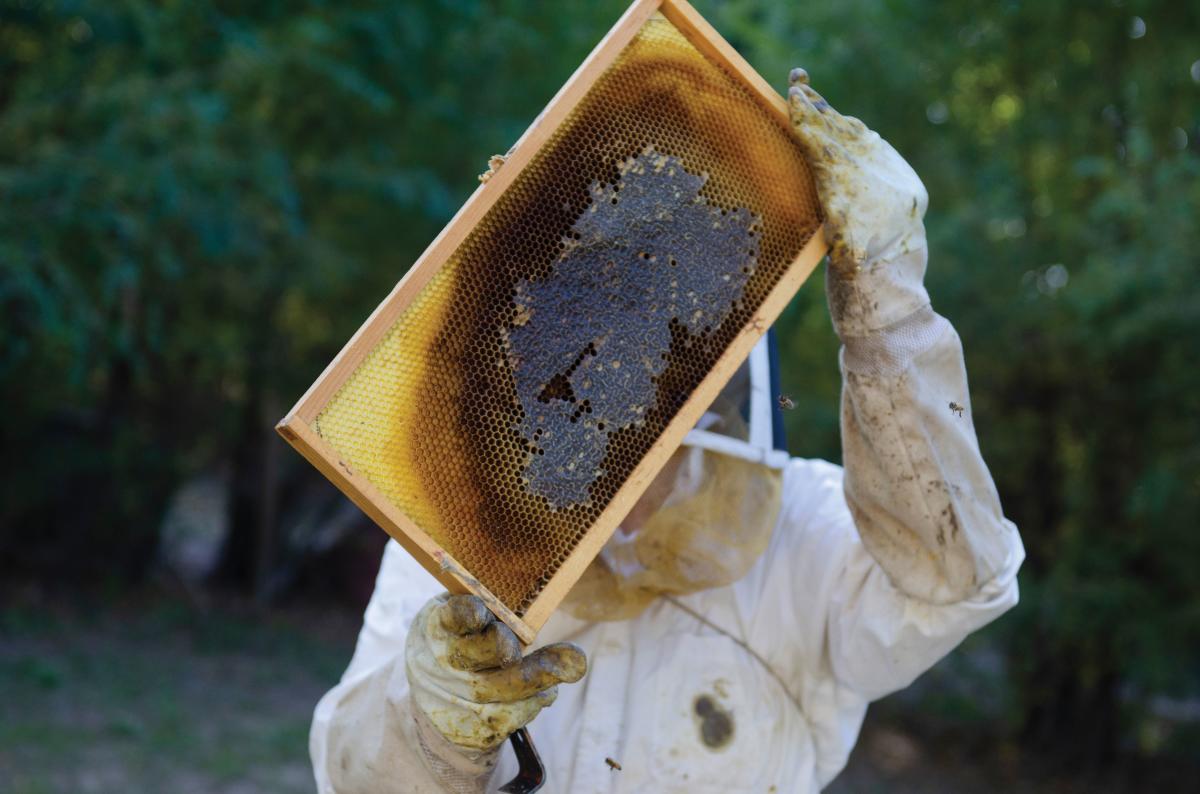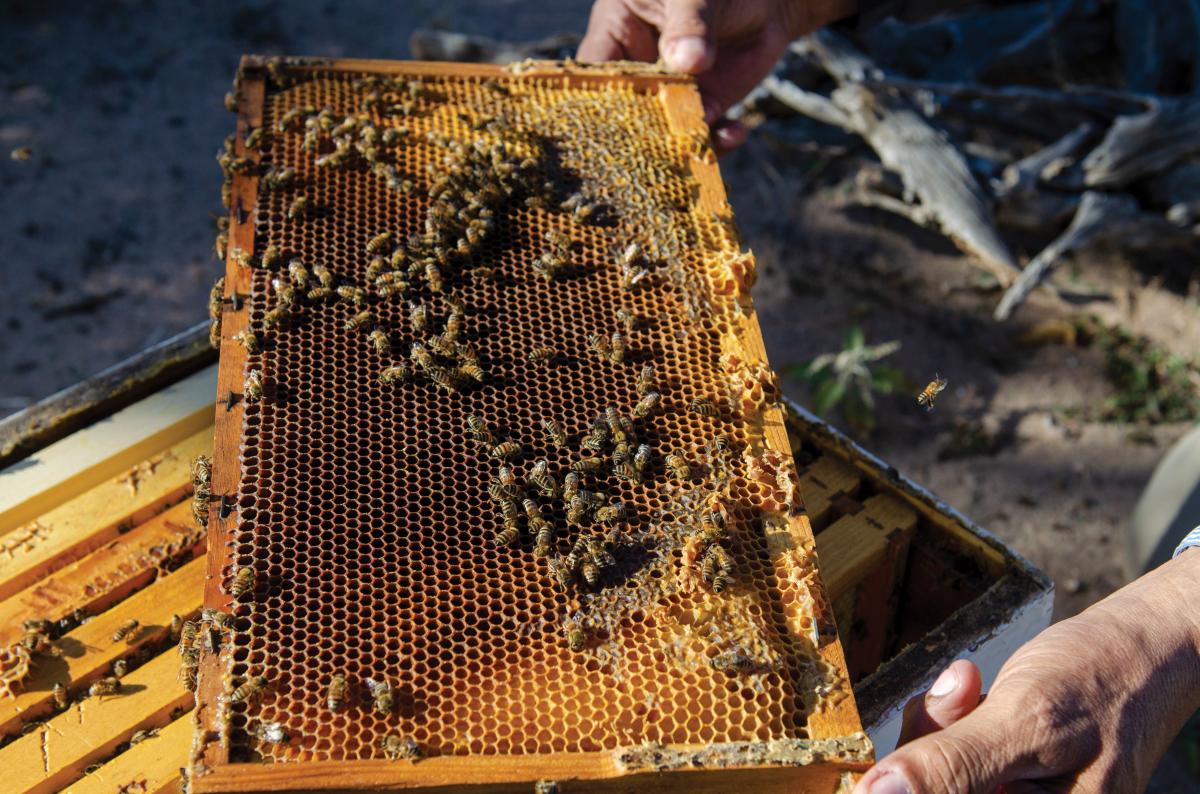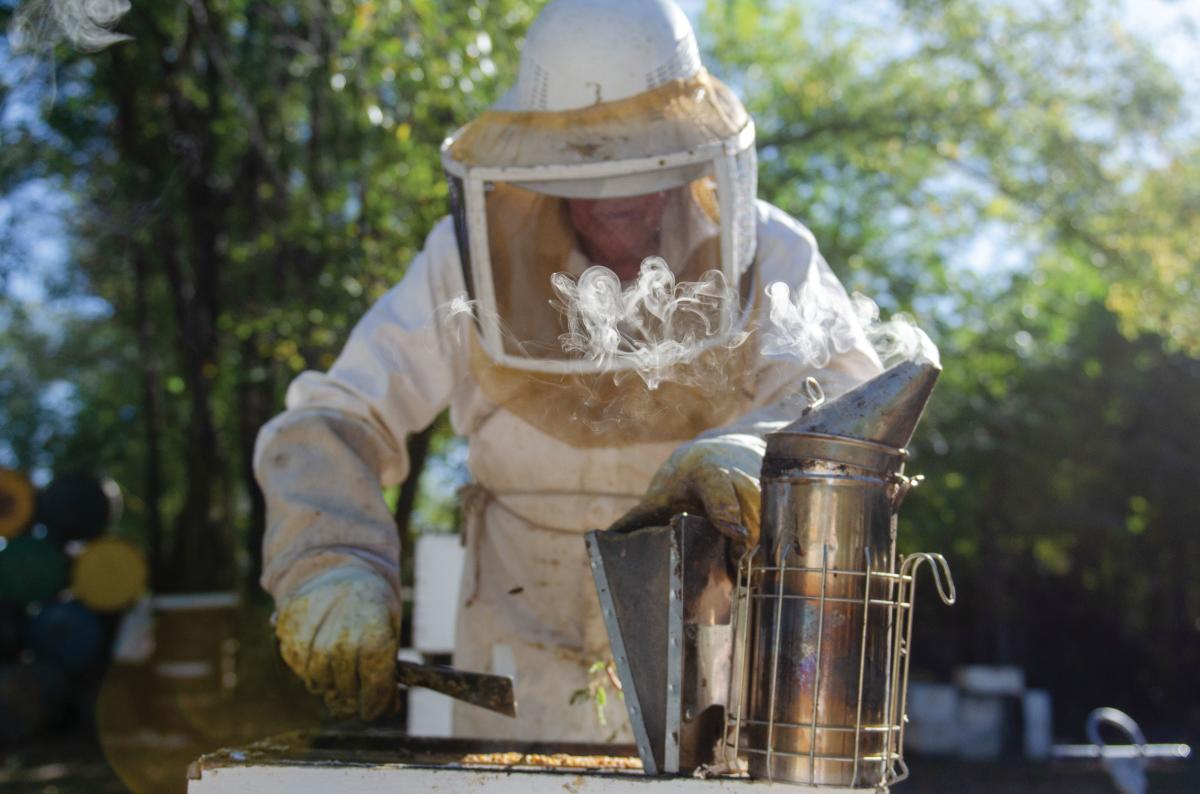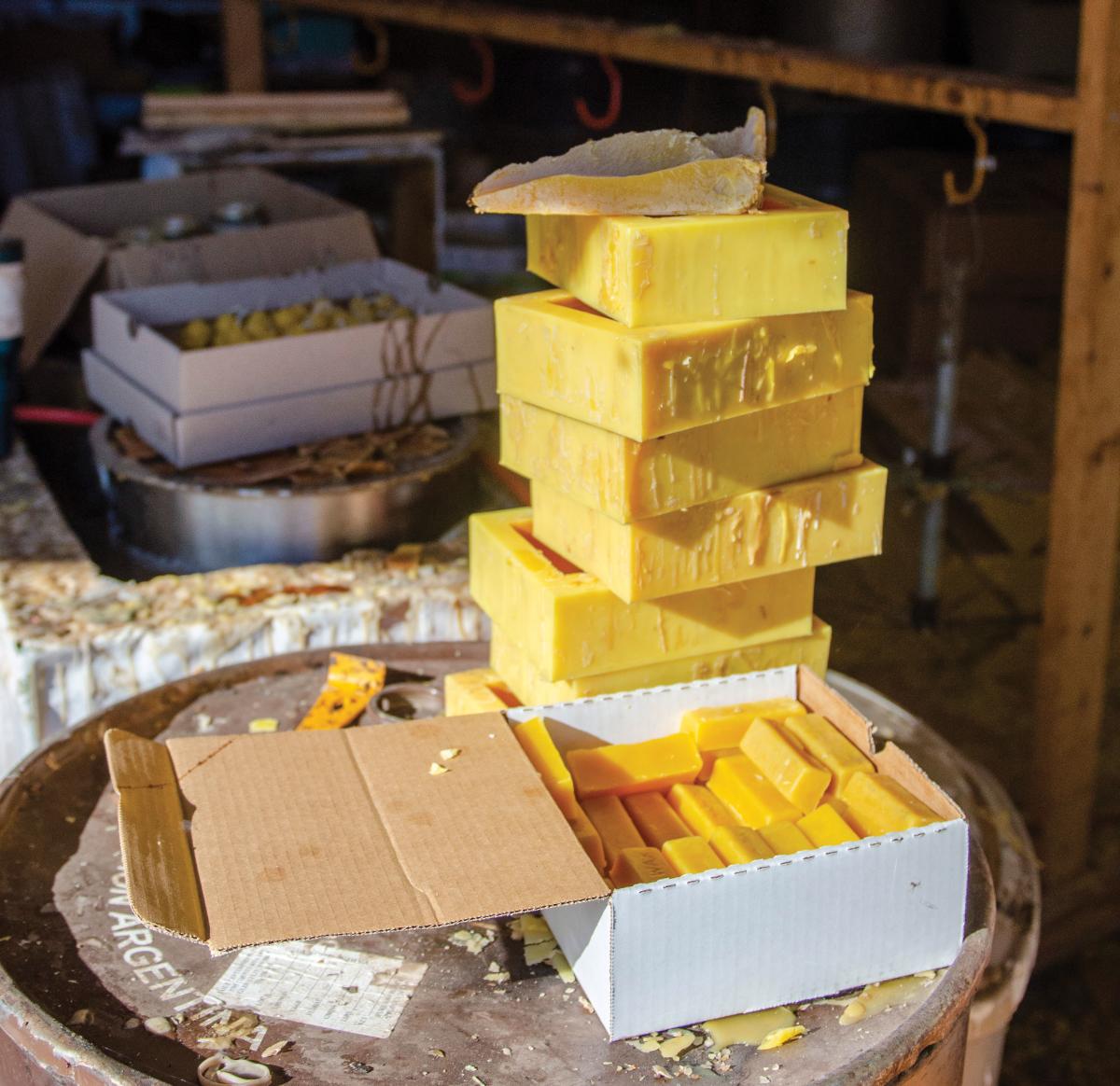AFTERNOON SUNSHINE FILTERS through the leaves of commercial beekeeper Ken Hays’s bucolic apple orchard in Bosque Farms, 18 miles south of Albuquerque. The play between sun and shadow creates what the Japanese call komorebi. It dances across Hays’s bleached overalls and bounces playfully against several white hive boxes, each one home to as many as 100,000 busy little honeybees. From a metal vessel, smoke performs its own seductive pirouette, penetrating the air with the peculiar scent of burning horse manure. The colony retreats, sedated, into the lower levels of the hive, except for a handful of daring girls who begin their airborne routines. The atmosphere pulses with a primal, life-affirming sound—a continual, energetic buzz atop a steady, rhythmic pulse. It is how I imagine the inside of a body might sound, if I could hear the movement of cells, the invisible currents that give us life. It is the music to which a company of sunlight, bees, and smoke realize their ballet.
Read more: A Bosque Farms dairy delivers milk the natural way.
Inside the 150 hives that Hays cares for, hundreds of thousands of wings beat in unison, 230 times per second. Wings that come into the world downy with branched hairs designed to collect the protein-rich pollen that sustains them—and their planet—only for the bees to fall still a few weeks later, slick and hairless from a short lifetime of altruistic deeds. Wings of newborn worker bees whose first job is to selflessly flap and flutter to keep the new generation of larvae at a steady 95 degrees. Wings that give life to the hive as its members collectively rear their young, remove their dead, disinfect and clean their home, make their honey, forage for pollen and nectar, tend to their queen, guard their home, and construct the immaculate hexagonal waxen chambers of their comb. Each one is born with a job it instinctively knows how to do.
 A honeycomb, up close.
A honeycomb, up close.
“Bees are a work of art. They work together as one unit so much better than people,” says Hays, a self-proclaimed “old drone.” A commercial beekeeper who has been at the task since 1970, Hays has one of only seven licensed apiaries in the state, though he estimates there are at least 1,000 people statewide who keep bees as a hobby. According to Tiffany Johnson, an entomologist for the New Mexico Department of Agriculture, qualifying for a state license depends on the number of hives one has and where they are located in relation to I-40. Beekeepers north of it must have a minimum of 15 hives; those south need at least 25.
Hays is a true bee ambassador who, after 17 years as president of the New Mexico Beekeepers Association, dedicates his time to educating the community about honeybees and the therapeutic properties of their various products. Local honey is a home cure for seasonal allergies and what first attracted Hays to the hobby, which then become a passion and eventually a business. He soon discovered that the business of keeping bees also yields other benefits, including bee pollen rich in vitamins, protein, and other nutrients, as well as multi-purpose beeswax. And he came to admire the antibacterial properties of propolis, a resin the bees collect from trees to disinfect their homes. And then there is bee venom therapy, an ancient practice of administering bee stings to relieve ailments such as arthritis. Hays and his wife, Sherry, the “queen bee,” credit their own longevity to the many gifts their bees share with them, all of which they now sell from the Hays Honey & Apple Farm store. The shop smells sweetly of the beeswax candles Sherry makes in all sorts of whimsical shapes, and guests are encouraged to taste the different flavors of honey.
When they do, they’re tasting history. The honeybee arrived in New Mexico around 500 years ago with Spanish settlers—domesticated just like sheep, cattle, and pigs. Looking to their future and the longevity of their species in this state and beyond means examining what honeybees have in common with their wild native counterparts. For several years, honey and native bees have declined in number due to habitat loss, pesticide pollution, parasites, and climate change. Hays and other New Mexico beekeepers and scientists have seen those consequences firsthand and are working to educate themselves and others about how invaluable bees are to the circle of life.
“You can’t help but look at the bees and see how God made them specifically for us,” says Hays. “One-third of everything you put in your mouth is dependent on pollination by all types of bees.”
 A honeycomb straight from the hive box.
A honeycomb straight from the hive box.
THE ORIGIN STORY of these angels of agriculture begins 120 million years ago, following the appearance of the earth’s first flowering plants. They evolved from short-tongued wasps during the Cretaceous period to survive millions of years beyond the mass extinction of dinosaurs, 66 million years ago. Today, honeybees count as one of 20,000 known species of bees on the planet and are unique in their ability to produce honey and forge large “eusocial” societies—the most evolutionarily advanced among colony groups. Their form of communication, the most developed of any invertebrate, includes seven dances they use to alert their families about the location and distance of desirable pollens.
Honeybees also have a remarkable ability to clean their hives, develop natural defenses, and even self-medicate by choosing to eat from plants that benefit them, all of which have kept them healthy and thriving for millions of years, even beyond the largest mass extinctions. So, in the early 2000s, when colonies started to collapse, scientists knew something was very, very wrong.
 Several dozen of honeycomb boxes on the Hays's farm.
Several dozen of honeycomb boxes on the Hays's farm.
“We have lost half of the bees on the planet for one reason: the Varroa destructor mite,” says Hays, who lost most of his 150 hives in 2016. “We have millions of dollars in research right now to try to eradicate this guy. They’re breeding queens where their offspring can kill the mites, and we have a lot of them that can do it. The problem is, the mites multiply twice as fast as the bees, so they can’t kill enough of them, so we step in with natural pesticides like formic acid and oxalic acid.”
In his younger years, Hays, who’s 82, regularly hired out his hives to pollinate commercial crops around the state, including apple orchards in Clovis and watermelon fields in Portales. Because of their ability to pollinate many types of plants, managed honeybees are the most reliable pollinators in agriculture. Think of New Mexico’s alfalfa hay, which travels around the country to feed livestock that in turn feed us. It’s our top agricultural crop, and it’s entirely dependent on bee pollination. Across the U.S., bee pollination is responsible for billions of dollars of added crop value, but exposure to harmful chemicals while on the job is now being linked to colony collapse as well.
Beekeepers like Hays and entomologists at the Department of Agriculture and universities advocate for a change away from traditional pest management, including the use of harmful pesticides. But due to the higher cost of natural alternatives, many farms around the country are still using products like chlorpyrifos on many honeybee-dependent crops like soybeans, broccoli, and apples. Researchers believe that even residual exposure to this and other pesticides, herbicides, and fungicides causes weakened immune systems in bees, which makes them more susceptible to parasites like the Varroa mite. In addition, due to urban development and large monoculture farms, bees now have access to a smaller variety of food sources than they did pre–World War II, which results in the possibility of further sickness from malnutrition.
“Recently, researchers from Penn State University have started looking at the pesticide residue in the loads of pollen that bees carry home as food, and they’ve found that every batch of pollen that a honeybee collects has at least six detectable pesticides in it, and this includes every class of insecticides, herbicides, fungicides, and even inert and unlabeled ingredients that … can be more toxic than the active ingredient,” explained Marla Spivak, an entomology professor at the University of Minnesota. “This small bee is holding up a large mirror. How much is it going to take to contaminate humans?”
 Hays uses smoke to sedate the bees.
Hays uses smoke to sedate the bees.
Recognizing the long-term threats pesticides pose, New Mexico State University’s Cooperative Extension Service—the network of county agencies that take academic research and make it so people like you and me can apply it to our farms, gardens, and livestock—are making a priority of integrated pest management (IPM).
“IPM is taking a holistic approach to pest management by trying to build a foundation of preventing pests and looking for different management strategies that are possible alternatives to going directly to a pesticide,” says Amanda Skidmore, an IPM specialist at the NMSU Agricultural Science Center, in Los Lunas. “We’re looking at the economics, the sustainability, and the environmental impacts in creating a plan to better manage your farm or garden.”
Besides being abuzz with domesticated honeybees, New Mexico is also home to 1,000 native bee species—a quarter of the bee species found in the U.S. Studies indicate that native bees also play an important role in pollinating crops. Their story is much the same as a honeybee’s: the critter’s small, pollen-dusted body moves from flower to flower, stamen to stigma, as she collects her food.
In New Mexico, native bees have long thrived in the wide range of growing zones and open spaces, making the state home to one of the most diverse bee populations in the country. Ranging from gnat size to the chubby bumblebee, most of these native species are solitary rather than social, travel short distances, and nest underground or in hollow sticks. Many will choose a multitude of flowers, while others specialize in one or two. For example, the bumblebee has a unique ability to vibrate loose stubborn tomato pollen, and the squash bee will be found collecting pollen only from pumpkins, melons, and their wild relatives. Compared with most states, New Mexico still has a lot of undeveloped land, which is good news for the native bee population. The presence of so much open space also makes New Mexico an ideal location for long-term bee research, which is crucial to understanding more about how bees are affected by a changing world and how we can protect them.
 Up close beekeeping on the Hays's farm.
Up close beekeeping on the Hays's farm.
The Sevilleta National Wildlife Refuge, near Socorro, is one of New Mexico’s two Long-Term Ecological Research (LTER) sites, funded by the National Science Foundation. In 2002, Karen Wright, who now works in the Department of Entomology at Texas A&M, started collecting ecological data and studying changes and patterns there. Every year since, researchers at Sevilleta have trapped and collected bees from three different ecosystems at the site, building the world’s longest continuously running bee-monitoring study.
Within that data, says Melanie Kazenel, a PhD candidate in biology at UNM and a researcher at Sevilleta, is a sobering reminder of the need to help wild bees in addition to honeybees. “Native bees may be more at risk of decline or disappearance,” she says. Some of the important findings out of the Sevilleta involve the impact of climate change on bee counts. Research shows that some species have declined over time, while others have increased, suggesting that climate shifts, while hurting most bees, might benefit others.
“One of the beautiful things about the natural world is that it’s incredibly complicated, and identifying simple solutions to environmental issues can be difficult,” says Kazenel. “But there are some simple steps we can take to help counter bee declines. Planting flowers that are good food sources for bees and reducing pesticide use are tangible, meaningful actions that can help both wild bee populations and honeybees.”
 The Hays Farm produces beeswax and other bee products.
The Hays Farm produces beeswax and other bee products.
OVER AT THE HAYS HONEY FARMS, the bees are getting back to business. As days reach above 57 degrees, colonies start to transition out of hibernation behaviors and begin building their population. New queen bees will take to the sky to meet thousands of male suitors from other colonies. Drawn together by powerful pheromones, drones and a virgin queen conduct a deadly dance in the sky. During the mating ritual, a queen stores enough sperm to last her a lifetime and create enough baby bees to keep the colony healthy. A drone’s only job is to find and mate with a queen, a task so forceful it will result in his death. From this violent rite will come a new generation of worker bees, and the cycle of life will begin anew.
Soon, all throughout Hays’s apple orchard, ephemeral clouds of white blossoms will nourish his bees, who in turn will allow the trees to grow fruit to feed the community. “It’s not all about what we have, but how we can help people and teach people how to feed themselves,” says Hays. The second Saturday in May, his family will host their annual bee seminar at the farm. It’s an immersive, daylong event where anyone can come to learn the ins and outs of beekeeping and even leave with the tools needed to take up the hobby.
Events like this give Hays confidence that, despite the problems facing bees, they have a “fantastic future” ahead of them. “I think bees are wonderful, and the reason they aren’t going to die out is people like me,” he says. “We beekeepers never get discouraged. No matter what.”
POLLINATOR POWER
Miranda Kersten, senior program specialist at the Los Lunas Agricultural Science Center, stresses the importance of planting native flowers and leaving areas wild for bees to make their homes. Look for flowers that bloom in the fall and spring, when bee food is most scarce. Every county has an extension office working with New Mexico State University to help people select bee-friendly plants. Here are a few, courtesy of NMSU.
Spring-flowering shrubs: native willow, skunkbush sumac, New Mexico olive, chokecherry. Summer-flowering annuals: prairie sunflower, Rocky Mountain bee plant, blue-headed gilia, golden crownbeard, basil. Summer-flowering perennials: firewheel/Indian blanket flower, red dome blanket flower, whorled mountain mint, white prairie clover, catmint, showy goldeneye, Mexican hat, fern bush. Late-summer- and autumn-flowering species: globe mallows, Emory’s baccharis, sneezeweed, native goldenrods.
COLONY CONFERENCES
Planning for Pollinators, a free open-house event at the Los Lunas Agricultural Science Center, takes place April 18 from 9 a.m. to 2 p.m. Explore the learning farm and speak to experts on beekeeping, pollinators, gardening, and more (loslunassc.nmsu.edu).
Hays Honey & Apple Farm hosts its annual Introduction to Beekeeping Seminar, an all-day event, on May 9. Spend the day among apple trees and beehives while learning from one of the most knowledgeable beekeepers in the state. Reservations recommended; call 505-869-2369. While you’re there, pick up some New Mexico honey. Hays recommends mesquite honey for barbecuing, whipped clover honey for sopaipilla eating, and the wildflower blend for a true taste of New Mexico.


